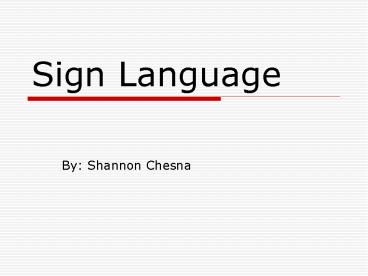Sign Language PowerPoint PPT Presentation
Title: Sign Language
1
Sign Language
- By Shannon Chesna
2
ASL
- American Sign Language uses signs in visual or
spatial form. - Independent of English
- Derived from French Sign Language
- 5 parameters of signs
- Hand configuration, place articulation, movement,
orientation (palm up or down), and facial
expression
3
Differences from Spoken Language
- Most spoken languages are arbitrary
- No relationship between set of sounds and the
object that the sound represents - Example catepillar (big word for small object)
- ASL is mainly iconic
- The signs represent the objects
- Example tree (forearm upright with hand spread)
- Even though these signs may represent something,
they are not always transparent in meaning. - Klima and Bellugi performed a study where results
showed that only 10 of iconic symbols were
identified by hearing observers.
4
Differences cont.
- Frishberg claimed that the level of iconicity has
declined in the past 200 years. - To become more conventionalized
- Example Home used to be the signs eat followed
by sleep. Now it is cupping your hand and
touching two places on your cheek. - ASL is now a dual system of reference
- Part iconic and part arbitrary
5
Differences cont.
- In spoken languages there are just 1 serial
stream of phonemes (sequential) - Sign Language can have multiple things going on
at the same time (simultaneous) - ASL has its own morphology (rules for creation of
words), phonetics (rules for hand shapes), and
grammar that are unlike spoken languages
6
Differences cont.
- Spoken languages have sound as basic building
block for emotion or feeling - Sign language is visual so it relies on facial
expressions and movement to convey emotion
7
Similarities to Spoken Language
- Morphology
- Distinctions from first and second person are
differentiated by movement - Ex ask me- movement of sign towards self and
ask you- movement of sign away from self - Reciprocity is whether the subject is the cause
or recipient of the object or if it is mutual - Ex They pinched each other- sign with movement
back and forth across signers body - English uses the distinction with pronouns
8
Similarities
- English uses subject-verb-object by word order
- ASL sometimes uses this with verbs that need a
direct object, they are signed subject-object-verb
.
9
Similarities
- ASL uses spatial processes to indicate certain
nouns - Ex He said he hit him, and then fell down.
- In English this is ambiguous but because ASL uses
these spatial processes, it is a clear
interpretation.
10
Error similarities
- Thompson, Emmory, and Gollan Study
- Found the tip of the finger experiences to be
similar to tip of the tongue experience. - Signers were more likely to retrieve a target
signs hand configuration and place of
articulation than its movement. - Results provide evidence that parameters are
independent
11
Error similarities
- Slip of the tongue errors occur in sign language
as well however slips of hand - Ex Deaf woman
- Points to possibility that both types of
languages take form because of basic cognitive
limits on how or how much linguistic information
may be structure or used.
12
Syntax
- Primarily conveyed through a combination of word
order and non-manual features - Pro-drop and doesnt have a capula (linking to
be verb) - Ex My hair is wet. Signs- MY HAIR WET.
13
Syntactic word order
- Places Adj. after noun
- Ex I have brown dogDOG BROWN I HAVE
- Adv. Occur before verbs
- Ex I enter the house quietly HOUSE I QUIET
ENTER - Modal verbs come after main verb of clause
- Ex I can go to the store for you. FOR YOU,
STORE I GO CAN
14
Syntax
- Negation
- Ex I dont have any dogs DOG I HAVE NONE
- Questions
- Ex What are you eating? YOU EAT WHAT?
- Raised eyebrows are used for rhetorical questions
- Subject pronoun tags
- Ex The boy fell downBOY FALL
15
Syntax
- Conjunctions
- and does not exist in ASL instead there are two
sentences combined by a short pause. or and
but often signed with slight shoulder twist - Ex I have two Cats and they are named Billy and
Bob. CAT TWO I HAVE. NAME B-I-L-L-Y B-O-B

